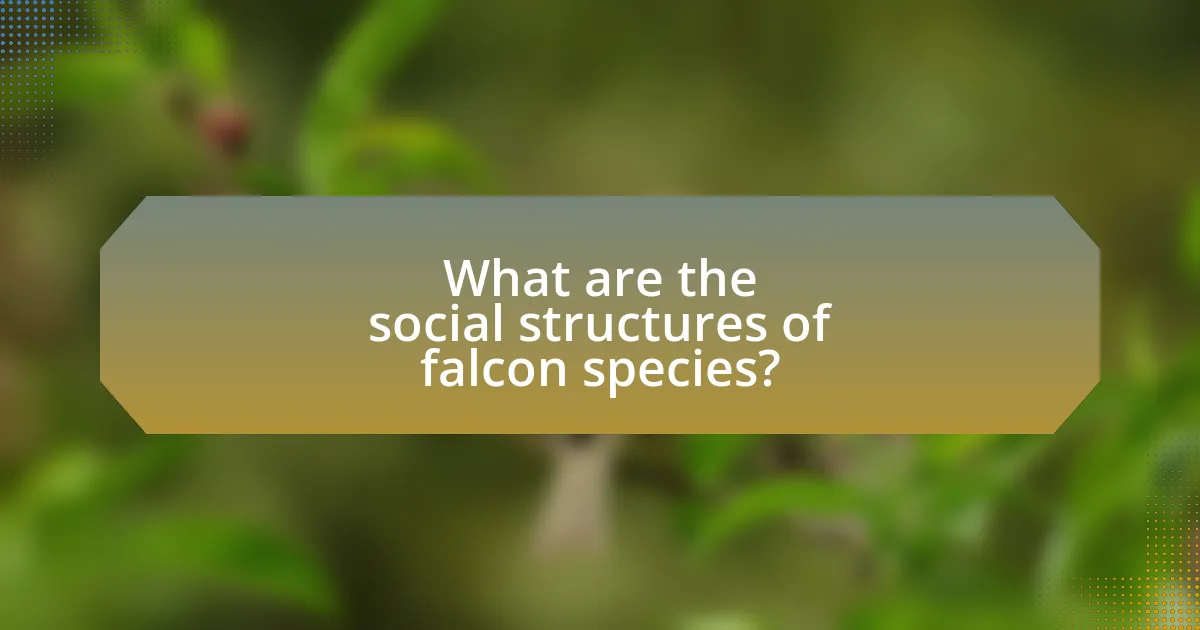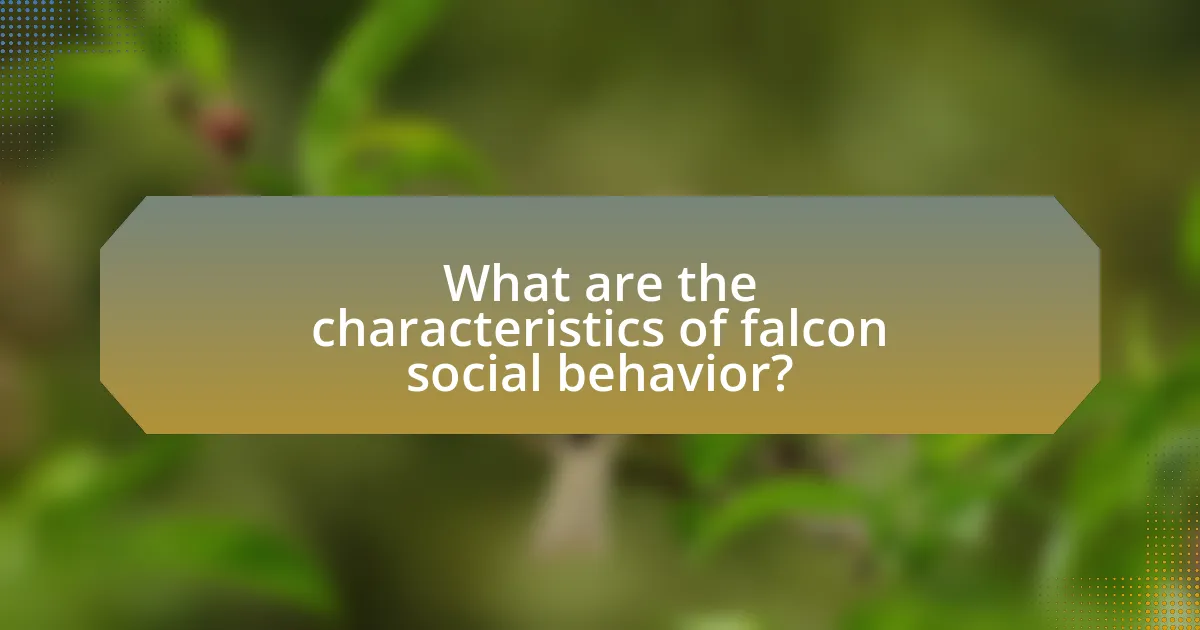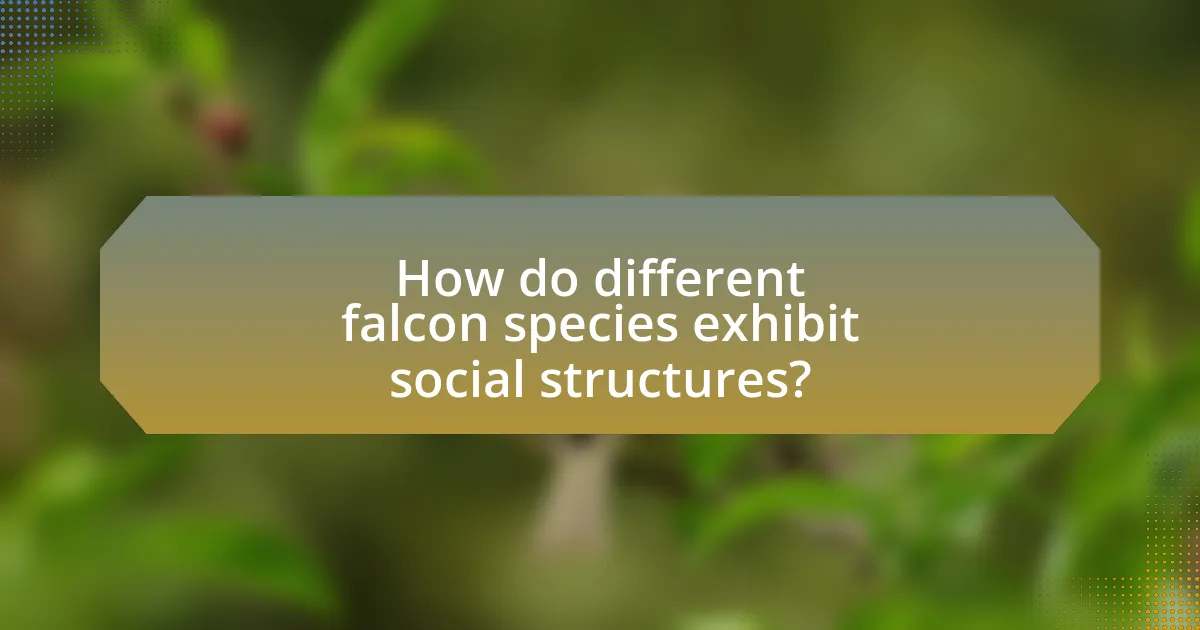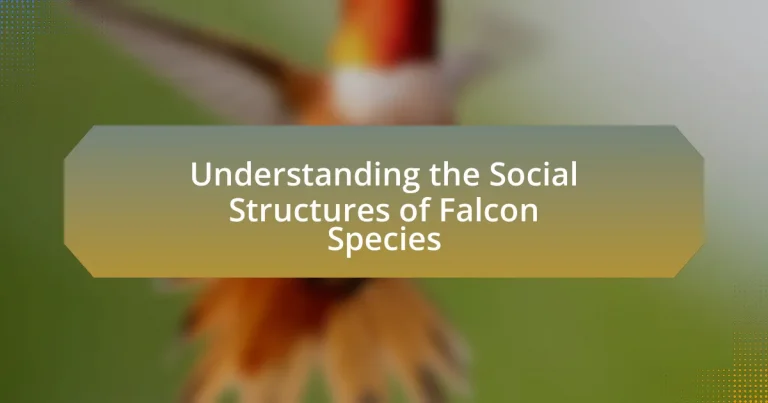The article focuses on understanding the social structures of falcon species, highlighting their solitary and monogamous behaviors, as well as cooperative breeding and communal roosting practices. It examines how environmental factors influence these social dynamics, affecting nesting, foraging, and territorial behaviors. Key insights include the benefits of social living for hunting efficiency and reproductive success, the role of communication through vocalizations and body language, and the implications for conservation efforts. The article also explores the unique social behaviors of various falcon species, such as the Peregrine Falcon, Harris’s Hawk, and Merlin, providing a comprehensive overview of their social interactions and structures.
What are the social structures of falcon species?

Falcon species typically exhibit solitary or monogamous social structures. Most falcons are solitary hunters, preferring to hunt and live alone, while some species, like the Peregrine Falcon, may form monogamous pairs during the breeding season. These pairs engage in cooperative breeding behaviors, such as sharing hunting duties and caring for their young. Research indicates that social structures can vary significantly among different falcon species, influenced by factors such as habitat, food availability, and breeding strategies. For example, the Prairie Falcon often displays territorial behavior, defending its hunting grounds from other falcons, which reinforces its solitary nature.
How do falcon species form social groups?
Falcon species form social groups primarily through cooperative breeding and communal roosting behaviors. These social structures often arise in environments where food resources are abundant, allowing falcons to benefit from group dynamics for hunting and protection. For instance, species like the American kestrel exhibit communal roosting, where multiple individuals gather in a single location during non-breeding seasons, enhancing their ability to detect predators and share information about food sources. Research indicates that such social interactions can lead to increased survival rates and reproductive success, as seen in studies of the Eurasian kestrel, which demonstrate that group living can improve foraging efficiency and reduce individual predation risk.
What types of social structures exist among falcon species?
Falcon species exhibit various social structures, primarily categorized as solitary, monogamous pairs, and communal nesting. Solitary behavior is common among many falcon species, where individuals hunt and live independently. Monogamous pairs, such as the Peregrine Falcon, form long-term bonds during the breeding season, sharing responsibilities for nesting and raising young. Communal nesting occurs in some species, where multiple pairs nest in proximity, benefiting from increased vigilance against predators. These social structures are influenced by factors such as habitat availability, prey density, and environmental conditions, demonstrating the adaptability of falcons to their ecological niches.
How do environmental factors influence falcon social structures?
Environmental factors significantly influence falcon social structures by affecting their nesting, foraging, and territorial behaviors. For instance, the availability of suitable nesting sites, such as cliffs or tall trees, directly impacts the density and distribution of falcon populations. Research indicates that in areas with abundant prey and optimal nesting conditions, falcons tend to form larger social groups, which can enhance cooperative hunting and increase reproductive success. Additionally, environmental changes, such as habitat destruction or climate variations, can lead to shifts in social dynamics, as falcons may adapt by altering their social structures to cope with resource scarcity. Studies have shown that falcons in urban environments often exhibit different social behaviors compared to those in rural settings, highlighting the role of habitat type in shaping their social interactions.
Why is understanding falcon social structures important?
Understanding falcon social structures is important because it provides insights into their behavior, breeding patterns, and survival strategies. Knowledge of these social dynamics helps researchers and conservationists identify critical habitats and social interactions that influence population stability. For instance, studies have shown that falcons exhibit varying degrees of sociality, which can affect their hunting success and reproductive outcomes. Understanding these structures allows for more effective management and conservation efforts tailored to specific species’ needs, ultimately aiding in their preservation and ecological balance.
What role do social structures play in falcon behavior?
Social structures significantly influence falcon behavior by dictating their hunting strategies, mating patterns, and territoriality. For instance, species like the peregrine falcon exhibit hierarchical social structures that affect their cooperative hunting techniques and nesting sites. Research indicates that in social groups, falcons can enhance their foraging success through coordinated efforts, which is particularly evident in species that hunt in pairs or small groups. Additionally, social interactions among falcons can lead to the establishment of dominance hierarchies, impacting access to resources and breeding opportunities. These behaviors are supported by observations of falcon populations in various habitats, demonstrating that social structures are integral to their survival and reproductive success.
How do social structures affect falcon breeding and nesting?
Social structures significantly influence falcon breeding and nesting behaviors. In species such as the peregrine falcon, social hierarchies can determine access to prime nesting sites and influence mate selection. Research indicates that dominant individuals often secure better territories, which leads to higher reproductive success, as seen in studies where nesting success rates were correlated with territory quality and social rank among breeding pairs. Additionally, cooperative breeding behaviors, observed in some falcon species, can enhance chick survival rates by allowing non-breeding individuals to assist in feeding and protecting the young.
What are the characteristics of falcon social behavior?

Falcon social behavior is characterized by a mix of solitary and social interactions, primarily influenced by species and environmental factors. Many falcon species, such as the Peregrine Falcon, exhibit territorial behavior, especially during breeding seasons, where they defend their nesting areas aggressively against intruders. Additionally, some falcons, like the Merlin, may engage in social hunting or roosting in small groups, particularly during migration or in areas with abundant food resources. Research indicates that social structures can vary significantly among different falcon species, with some forming loose colonies while others remain strictly solitary. This variability highlights the adaptability of falcons to their ecological niches and the importance of social behavior in their survival and reproductive success.
How do falcons communicate within their social groups?
Falcons communicate within their social groups primarily through vocalizations and body language. Vocalizations include a variety of calls that convey different messages, such as alarm calls, mating calls, and calls to maintain contact with other group members. For instance, the peregrine falcon uses a series of high-pitched screams to signal distress or to warn others of potential threats. Body language, such as posturing and flight displays, also plays a crucial role in communication, particularly during courtship or territorial disputes. These methods of communication are essential for maintaining social bonds and coordinating group activities, which are vital for their survival and reproductive success.
What vocalizations are commonly used by falcons?
Falcons commonly use a variety of vocalizations, including high-pitched calls, whistles, and screeches. These vocalizations serve different purposes, such as communication during mating, signaling alarm, or establishing territory. For instance, the peregrine falcon is known for its distinctive “kak-kak-kak” call, which is often used to communicate with its mate or to warn off intruders. Research indicates that these vocalizations play a crucial role in the social interactions and hierarchical structures within falcon species, helping to maintain pair bonds and coordinate hunting efforts.
How does body language contribute to falcon communication?
Body language significantly contributes to falcon communication by conveying emotions and intentions through specific postures and movements. For instance, a falcon may display aggressive body language, such as puffing up its feathers or spreading its wings, to assert dominance or deter rivals. Conversely, relaxed postures, like a lowered head and tucked wings, indicate submission or comfort. Research indicates that these non-verbal cues are crucial for establishing social hierarchies and facilitating interactions among falcons, as they rely heavily on visual signals in their communication repertoire.
What are the benefits of social living for falcons?
Social living for falcons provides several benefits, including enhanced hunting efficiency and increased protection from predators. By living in groups, falcons can coordinate their hunting strategies, allowing them to target larger prey or cover more ground, which improves their overall success rate. Additionally, social structures enable falcons to share information about food sources and potential threats, thereby increasing their survival chances. Research indicates that species like the peregrine falcon exhibit social behaviors that facilitate cooperative hunting, which can lead to higher food acquisition rates compared to solitary hunting.
How does social structure enhance hunting success?
Social structure enhances hunting success in falcon species by facilitating coordinated group hunting strategies. In species such as the Harris’s hawk, individuals work together to flush out prey, increasing the likelihood of a successful catch. Research indicates that this cooperative behavior allows for more efficient hunting, as group members can cover larger areas and utilize diverse hunting techniques, leading to higher overall success rates. For instance, studies have shown that Harris’s hawks can achieve up to 50% more successful hunts when hunting in groups compared to solitary efforts.
What advantages do falcons gain from cooperative breeding?
Falcons gain several advantages from cooperative breeding, primarily enhanced survival rates and increased reproductive success. By working together, adult falcons can share the responsibilities of feeding and protecting the young, which leads to higher chick survival rates. Research indicates that in species like the Eurasian kestrel, cooperative breeding can result in up to 50% more fledged young compared to solitary breeding. Additionally, cooperative breeding allows for the pooling of resources and knowledge, which can improve foraging efficiency and territory defense, further contributing to the overall fitness of the group.
How do different falcon species exhibit social structures?

Different falcon species exhibit varying social structures primarily through their nesting behaviors and interactions during breeding seasons. For instance, the Peregrine Falcon often displays solitary nesting habits, while species like the Prairie Falcon may nest in loose colonies, indicating a more social structure. Additionally, some falcon species, such as the Merlin, engage in cooperative hunting and communal roosting, which further illustrates their social dynamics. These behaviors are supported by observations that show how environmental factors and prey availability influence social interactions among different falcon species.
What are the social dynamics of the Peregrine Falcon?
The social dynamics of the Peregrine Falcon primarily involve solitary behavior, with individuals typically maintaining a territory during the breeding season. These birds are known for their aggressive territoriality, especially males, who defend their nesting sites from intruders. During the non-breeding season, Peregrine Falcons may exhibit more social behavior, sometimes forming loose groups or flocks, particularly in areas with abundant food sources. Research indicates that their social interactions are largely driven by the need for food and nesting sites, with dominance hierarchies established during territorial disputes.
How do Peregrine Falcons establish territories within their social groups?
Peregrine Falcons establish territories within their social groups through vocalizations, displays, and aggressive interactions. These behaviors help to communicate ownership of a specific area to other falcons, thereby reducing conflicts. Research indicates that territoriality is crucial for breeding success, as it ensures access to resources such as food and nesting sites. Studies have shown that male Peregrine Falcons often engage in aerial displays to assert dominance and defend their territory against intruders, which is vital for maintaining their social structure and reproductive success.
What unique social behaviors are observed in Peregrine Falcons?
Peregrine Falcons exhibit unique social behaviors such as cooperative hunting and territorial displays. These birds often hunt in pairs or groups, utilizing coordinated strategies to capture prey more effectively. During the breeding season, they engage in aerial displays, including high-speed dives and intricate flight patterns, to establish and defend their territory against rivals. These behaviors are essential for their survival and reproductive success, as they enhance hunting efficiency and ensure access to prime nesting sites.
How do social structures vary among other falcon species?
Social structures among falcon species vary significantly, with some exhibiting solitary behaviors while others display social nesting and cooperative hunting. For instance, the Peregrine Falcon typically leads a solitary lifestyle, while the Harris’s Hawk is known for its unique social structure that includes cooperative breeding and hunting in family groups. Research indicates that these differences in social behavior are influenced by ecological factors, such as prey availability and habitat type, which dictate the need for social cooperation or solitary living.
What social behaviors are seen in the Merlin Falcon?
The Merlin Falcon exhibits social behaviors such as forming loose flocks during migration and engaging in cooperative hunting. These birds often gather in groups, especially in wintering areas, which enhances their foraging efficiency and provides safety in numbers. Observations indicate that Merlins may also engage in aerial displays and vocalizations to communicate with one another, reinforcing social bonds within these groups.
How does the social structure of the Gyrfalcon differ from that of the Peregrine Falcon?
The social structure of the Gyrfalcon is generally more solitary compared to the Peregrine Falcon, which often exhibits more social behaviors, especially during breeding and hunting. Gyrfalcons tend to establish and defend large territories, with pairs typically remaining together during the breeding season but not forming larger social groups. In contrast, Peregrine Falcons may hunt cooperatively and can be found in larger aggregations, particularly in areas with abundant prey. This difference is supported by observations of their behaviors in various habitats, where Gyrfalcons are noted for their solitary hunting style, while Peregrine Falcons are frequently seen in pairs or small groups during migration and hunting activities.
What practical insights can be gained from studying falcon social structures?
Studying falcon social structures provides practical insights into their hunting strategies, territorial behaviors, and breeding success. These insights reveal how social interactions influence resource allocation and survival rates among falcons. For instance, research indicates that species like the peregrine falcon exhibit complex social hierarchies that affect their hunting efficiency, as cooperative hunting can lead to higher prey capture rates. Additionally, understanding these social dynamics can inform conservation efforts, as preserving key social structures may enhance population resilience and adaptability in changing environments.
How can understanding falcon social behavior inform conservation efforts?
Understanding falcon social behavior can significantly inform conservation efforts by revealing how these birds interact within their communities, which is crucial for habitat management and species recovery strategies. For instance, knowledge of their nesting habits, territoriality, and social hierarchies can guide the establishment of protected areas that accommodate their social structures. Research has shown that falcons, such as the Peregrine Falcon, exhibit complex social behaviors that influence their breeding success and survival rates. By studying these behaviors, conservationists can implement targeted interventions, such as creating artificial nesting sites or managing prey availability, to enhance population stability.
What best practices can be applied in falcon rehabilitation based on social structures?
Best practices in falcon rehabilitation based on social structures include creating social environments that mimic natural group dynamics and fostering social interactions among rehabilitated falcons. Research indicates that falcons are social creatures that benefit from interactions with conspecifics, which can enhance their social skills and reduce stress during rehabilitation. For instance, studies have shown that group housing can lead to improved behavioral outcomes, as falcons learn from each other and establish social hierarchies similar to those in the wild. Additionally, incorporating social learning opportunities, such as allowing falcons to observe and interact with experienced individuals, can facilitate the acquisition of essential survival skills.

